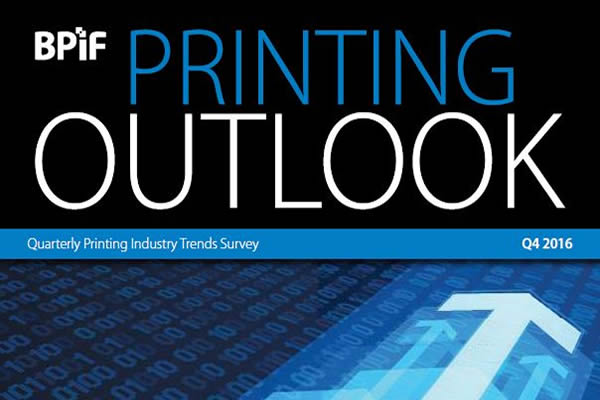The latest ‘Printing Outlook’ survey from the BPIF reveals that 32% of printers polled were able to increase output in the third quarter of 2016, 38% maintained output levels, and 30% experienced a fall in output - much better overall than the pessimistic forecasts for the period.

With a seasonally busy Q4 period ahead, the industry is not now expected to dip into the negative zone again this year (in Q1 the balance was -1). Nearly two-fifths of respondents predict that they will increase output levels in Q4 and 46% expect output levels to hold steady; only 16% forecast that output will fall in Q4. The forecasted balance of +21 would, if realised, be a welcome turnaround in expectations. The 2016 Q4 forecast is admittedly lower than the Q4 forecasts and realised balances from recent years - however, it represents a significant turnaround in expectations from those for Q3.
The balance between those believing that the general state of trade improved, and those believing that it had deteriorated, was -4 in Q3; up from -10 in Q2, and some way above the Q3 forecast of -26. The negative balance for Q3 has come from 28% believing the general state of trade in the printing industry had improved and 32% reporting that there had been deterioration. 40% reported no change in the general state of trade in Q3 2016. It is clear that confidence is down – however, as with output, the reality for Q3 in no way compares to the forecasts that were made in the immediate Brexit referendum outcome.
Confidence is looking more positive as we move into Q4; though is not expected to recover to the same extent as output and orders. An increased proportion of respondents, almost two-thirds, expect that the general state of trade in the industry will remain unchanged. However, more (21%) now forecast an improvement as opposed to a deterioration (13%) in the general state of trade in the UK printing industry in Q4 2016.
Competitors pricing below cost continues to be the most voiced business concern – collecting the same proportion as last quarter; it was selected by nearly two-thirds (64%) of respondents. The main change for this quarter has been a quick and significant rise in the proportion of respondents selecting paper and board prices as a top three concern. Six months ago paper and board prices were a top three concern for only 10% – this has now increased to 50%. Such a dramatic increase can most likely be accounted for by the effect the devaluation of sterling has on the price UK printers pay for their paper and boards, the vast majority of which are imported to the UK. Access to skilled labour has also increased share – to become the third ranked concern – with 29% of respondents selecting it in Q3; up from 24% in Q2.
Whilst the evidence for orders, output and business confidence tends to suggest that the forecasts made in the immediate EU referendum aftermath have proven to be overly pessimistic, it remains true that Brexit (and the effects surrounding Brexit) is still a major concern for printers. Further to the links from Brexit to paper and board prices and access to skilled labour; Brexit, and exchange rates, took the lion’s share of selections in the ‘Other’ category.
Charles Jarrold, BPIF chief executive, said: “The climate is tough yet over half of respondents to ‘Printing Outlook’ report that their own businesses are expanding. The industry is showing that it can be successful despite the numerous challenges thrown our way.
“Paper and board price rises – resulting from the devaluation in sterling that has been stimulated by the Brexit outcome in the EU referendum – is the latest challenge the industry is facing; it is not a new one. Some companies will be protected, to some degree, by their ability to target export markets; others may have paper price adjustments written in to some of their supplier contracts. However, many will have a decision to make about whether or not they can pass cost increases on in higher prices, afford to take the hit in their margins or look to mitigate cost increases through their purchasing or through efficiencies elsewhere in their business. The industry is highly experienced in managing its costs carefully and that experience will be valuable as businesses face some difficult choices.”

